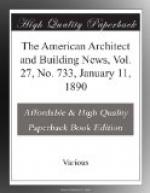to it for the instant indication of the return of
consciousness to any who had been prematurely entombed,
and would promise and provide the most perfect and
permanent protection against intrusion or theft that
can be found on earth. In arrangement these sepulchres
would have to conform to the price paid and the taste
of the purchaser. Many would be like the single
graves that thickly ridge portions of our cemeteries;
many more would be grouped together after the semblance
of a family-tomb; but in the general impression, in
the surroundings and suggestions, the resemblance
to the provisions of a cemetery would go no farther.
For here there could be no burning sun, no chilling
cold, no inclement storm; for the living, as they
should pay the last sad honor to the dead, or in any
subsequent tribute of affection, there could be no
exposure, and for the dead there would be only the
constant semblance of the comfort and the quiet of
the best-ordered and most tranquil home. Thus,
in providing the utmost that exacting affection and
sanitary science can require, and in taxing to the
utmost the resources of art, in architecture, in sculpture
and in the use of subdued and according hues and forms
for appropriate decoration, these “Campo Santos,”
or “Mausoleums,” or “Mansions of
the Dead,” will seem to have realized the ideal
disposition of the mortal remains of those who depart
this life.
FOOTNOTES:
[Footnote 3: Extracts from a paper read before
the Boston Electric Club, December 23, 1889, by F.C.
Child.]
[Footnote 4: Extracts from an address by Rev.
Charles R. Treat before the American Public Health
Association at Brooklyn, N.Y., October 23, 1889.]
* * * *
*
THE VEKPLANCK HOMESTEAD, FISHKILL, N.Y.
[Illustration: The Old Verplanck Homestead at
Fishkill, Hudson River, in which the Society of the
Cincinnati originated.]
The Verplanck homestead stands on the lands granted
by the Wappinger Indians, in 1683, to Gulian Verplanck
and Francis Rombout, under a license given by Governor
Thomas Dongan Commander-in-Chief of the Province of
New York, and confirmed, in 1685, by letters patent
from King-James the II. The purchase included
“all that Tract or Parcell of land Scituate
on the East side of Hudson’s river, beginning
from the South side of a Creek called the fresh Kill
and by the Indians Matteawan, and from thence Northward
along said Hudson’s river five hundred Rodd
beyond the Great Wappin’s Kill, and from thence
into the woods fouer Houres goeing”; or, in
our speech, easterly sixteen English miles. There
were eighty-five thousand acres in this grant, and
the “Schedull or Perticuler” of money
and goods given to the natives, in exchange, by ffrancis
Rumbout and Gulyne Ver Planke sounds oddly to-day:




